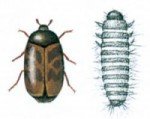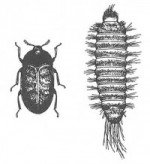
Lat: Trogoderma granarium.
The khapra beetle is a small, oval, dark brown beetle. It is between 1.5 and 3 mm. It originates from India. The word khapra is Indian and means brick. The beetle has been named because it often accumulates in large numbers in crevices in walls of warehouses. It has spread to almost all tropical and subtropical countries and appears as one of the more voracious pests of grain and feed storages. The khapra beetle is in fact, in contrast to the aforementioned species, herbivore.
The female lays about 50 eggs in food. At 30 ° C development from egg to adult beetle lasts approximately 40 days. At 25 ° C, it takes at least 60 days and at less than 24 ° C the khapra beetle cannot reproduce. If conditions are unfavourable, the larvae hide in cracks and crevices and go into a kind of hibernation. That way they can survive for years until food arrives to the warehouse. Its ability to hide makes the extermination quite difficult.

This inconspicuous beetle has become one of the world’s most unpopular storage pests. The khapra beetle was introduced in the United States at some point in 1952 – 1953. Here it spread quickly to a large part of the American malt houses, mills and grain storages and it was expensive to exterminate. Today the khapra beetle is still undesirable in imports in most of the world.




